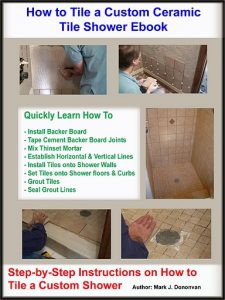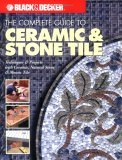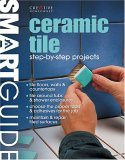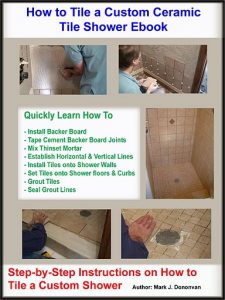It is Critical to Seal Tile Showers Periodically to Prevent Mold and Mildew Growth
By Mark J. Donovan
|
|
Sealing ceramic tile showers should be done every year or so. When it comes to keeping ceramic tile showers looking like new, besides wiping them dry after every use, you must also periodically seal ceramic tile showers.
Grout and some ceramic tiles are porous and as a result absorb moisture. If the ceramic tile shower is not sealed water can penetrate into the tile and grout, and breed mold and mildew. |
In addition, minerals in the water can also etch the surface of some glazed tiles.
Sealing tile showers protects them from absorbing water, and thus prevents mold and mildew growth, as well as protects against tile pitting.
Key Steps on How to Seal Tile Shower Walls and Floors
- Make sure the tile grout has cured for 2 to 3 days before sealing tile shower walls and floor.
- Ensure plenty of ventilation when sealing tile shower walls and floor.
- Use a tile sealer applicator bottle to apply tile sealer.
- Turn the applicator bottle upside down so the roller-wheel faces downward.
- Roll the wheel down the center of the grout line slowly making sure the tile sealer gets absorbed into the entire width of the grout line. But make sure to work in small sections when doing so.
- Use paper towels or rags to remove any excess tile sealer from the adjacent tiles.
- Allow the tile sealer to sit for about 10 minutes before removing any excess tile sealer from the grout lines.
- Move to another section of the tile shower area and repeat the process until all of the tile shower grout lines are sealed.
- Allow the tile sealer to cure for the manufacture’s prescribed time before using the shower.
| More about How to Seal Tile Shower Walls and Floors
In general, glazed ceramic tile does not need to be sealed. In addition, some types of unglazed ceramic tile do not need to be sealed. However all grout lines should be. See how to grout shower tile properly in this short video. |
 |
To determine if your unglazed ceramic tile needs to be sealed, apply a little water to the surface of one of the tiles and see if the tile turns darker. If it does, then the tile is porous and should be sealed.
| Sealing ceramic tile showers is easy to do and there are a number of tile shower penetrating sealers on the market to choose from.
There is latex or acrylic based tile sealers, as well as mineral based sealers. The mineral based tile sealers have a strong smell, whereas the latex or acrylic based ones do not. I recommend using the latex based tile sealers. Each offers various lengths of time between reapplication, however I find it is wise to seal a ceramic tile shower every couple of years. How to Seal Ceramic Tile Shower Walls When it comes to actually sealing ceramic tile showers, it is important to make sure that they are thoroughly dry first. |
 Learn how to tile a shower with this eBook. |
Keep in mind that it can take up to a week for shower wall tiles to completely dry, and even longer on tiled shower floors.
| Before applying a penetrating tile and grout sealer, make sure to read the instructions on the packaging first. In general, sealing ceramic tile showers is performed by applying tile sealer to the tile and grout lines using a rag or sponge.
After it has soaked in for a couple of minutes, the excess material is wiped off the ceramic tile and grout using a clean damp rag or paper towels. Note that you do not want to allow the tile sealer to sit very long on the ceramic tile, as it is can become nearly impossible to remove it once it has dried. |
 |
Apply a second coat to seal the tile shower for additional protection after you have allowed time for the first application to fully dry.
For information on installing a shower pan membrane liner for a ceramic tile shower, see the Shower Pan Membrane Liner Installation Ebook from HomeAdditionPlus.com. The Shower Pan Membrane Liner EBook will quickly teach you the step-by-step process for installing the shower pan membrane liner correctly. It includes instructions on framing the shower stall, pouring the pre-slope and shower base mortar, and installing the shower pan membrane liner.
See HomeAdditionPlus.com’s Ceramic Tile Calculator
See my “How to Tile a Custom Ceramic Tile Shower” Ebook to learn how to tile your own shower: For a detailed set of instructions on tiling a shower floor and walls, including pictures for every step in the process, see my “How to Tile Custom Ceramic Tile Shower Ebook”.
Related Information on How to Seal Tile Shower Walls and Floors
Additional Ceramic Tile Resources from Amazon.com
 |
 |
 |
Get Free Bathroom Remodeling Price Quotes with No Obligation!
Fill out our 3-5 minute quick and easy form, and receive a free price quote on a bathroom remodeling project from one of our pre-screened and licensed bathroom remodeling contractors. This process is free and there is no obligation to continue once you receive your bathroom addition price estimate.


